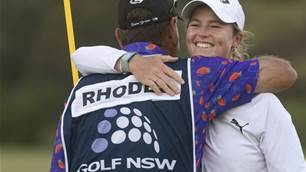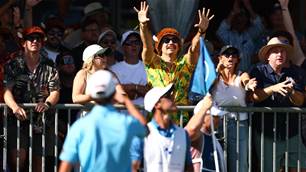Do you like poking fun at choking superstars? Give ShootOut Golf a try and be ready to crumble under the play-off pressure of your mates in the gallery.
Do you like poking fun at choking superstars? Give ShootOut Golf a try and be ready to crumble under the play-off pressure of your mates in the gallery.
 Scott Hookey tries to pretend there’s no one watching.
Scott Hookey tries to pretend there’s no one watching.Images: ShootOut Golf
As Bobby Jones once put it, there’s golf, and there’s tournament golf. To parse what the founder of the Masters really meant, there’s golf, and there’s golf when other people are watching you.Your correspondent shares one similarity with Jones – neither of us play, or played, golf for a living. There’s a Grand Slam’s worth of difference, though, between my contented bogey-plus weekends and the career of history’s greatest amateur, who despite possessing the purest of talent, was driven from the game at age 28. Too much pressure, he said, then went and volunteered to fight in World War II. If Jones couldn’t take it, the chances of the rest of us outside of Tiger Woods and Jack Nicklaus are nil. Even for good golfers – extending the definition of “good” to the guy winning your club’s Wednesday comp, to the talented kids in elite amateur events, to journeymen tour professionals filling leaderboards all over the world – the game becomes infinitely more difficult when a gallery’s scrutiny bears down on you. So it is that a collection of hardy golfing souls tee up at Terrey Hills Golf and Country Club in Sydney’s north. The event is called ShootOut Golf, and its core conceit is to combine an anyone’s-welcome handicap competition with the flavour of pro-style, late-Sunday afternoon, fourth-round pressure that is the most entertaining part of golf on TV. Handicap events are the staple of the club golfer’s experience, competitions in which players of varying skill level are balanced out by an assigned number of extra strokes (the worse you are, the more you get). Players carry around their handicap like a caste mark. The Brahmins at the very top are the scratch players, who are expected to play the golf course much like the pros do, against par. Next rung down are the single digit players, so termed because their handicaps are lower than ten. These single-figures possess a degree of skill and seriousness about their game, and one is usually way out of proportion to the other.
The most general handicap is 18, an added shot for every hole. In a triumph of mediocrity, an 18-marker most commonly takes home first prize in a handicap event for a simple reason: they make up the majority of most fields. But then there’s the real game within the game of golf – those players who manipulate their handicap to keep it artificially high, above a proper measure of their ability. In self-regulating golf, where you call penalties on yourself, these scoundrels have a special scorn reserved for them. In the United States they’re known as sandbaggers. In Australia they’re called burglars.Veterans of handicap comps know the drill: head out for 18 holes with three other people, play variously well or not, return to the clubhouse for a drink and the result, then grouse about how the winner was playing off an advantageously inflated number of strokes. The strength of ShootOut’s format is the winner has to close out a victory on the course. “It’s far better than sitting in here and waiting,” says Chris Parkes, creator of the concept. “Everyone can see who wins.”How it works: at the end of the round, six of the 18 holes are randomly drawn. Instead of a score for a full round, the players in the field add up a total for those half-dozen holes. The top eight totals advance to a four-hole, elimination play-off, while the rest of the field congregates to toast the good fortune of their fellow competitors with harrowing pressure.Like a poker game, it doesn’t matter how well you play throughout the night, only that you cash in on the big hands. Score well on the selected holes and a player in the middle of the pack can find himself in the play-off, while a finisher in the top five misses out.
 What pressure? Just that of the mocking gallery in the background.
What pressure? Just that of the mocking gallery in the background.Images: ShootOut Golf
After an indifferent round, your correspondent feels safe that he doesn’t have to worry about privately testing Jones’ proposition. But then the first three holes are drawn, and each corresponds to the scarce number of holes I actually played well on. Involuntary sweat beads on my brow – the thought of breaking into a play-off with a round as bad as mine is downright embarrassing. The fourth hole is drawn and a fifth, and my lack of results there put an end to the anxiety.My exuberant playing partner, “J-Rod”, a former pro baseballer, relishes the prospect of the play-off before the round. He qualifies second, and another player in our foursome, Grant, with the big, rolling hook, also makes it in. Whether it’s good karma or bad on the part of the group, it’s hard to say.The eight shooters play the 18th hole twice, first from the fairway as a long par-three, then as it is in regulation, a par-four. The first player up hits it to ten feet. What pressure?
The following seven take their shots, and the entire sequence is a reminder of – in golf – never to get ahead of yourself. One player, an older gentleman, hits the worst of the tee shots nearly out of bounds and visibly resigns himself to elimination. He proceeds to get up and down in two shots from 50 metres, a feat that many pros would admire, and safely advances to the second play-off hole.To manufacture added drama, ShootOut resolves ties on the play-off holes via a putt-off. Four players on the same score each face a cascading, downhill 15m putt on Terrey Hills’ 18th green for the one spot left on the second play-off hole. The first effort is good indeed, to within a metre – yet another feat a pro would take as his own in a heartbeat.Grant’s up next. He’s played first grade cricket in Sydney, so he has some measure of being watched out in the middle. What follows he’ll find hard to top – he buries the long, snaking putt with perfect pace, and a cheer rings out. The other players in the putt-off, J-Rod among them, have their backs turned so they get no advantage from seeing the line of the putt. The gallery lets them know before they turn around. “This happens all the time in putt-offs,” Parkes says.
The final four return to the tee, and after a wrong ball mix-up causes some discussion, the entire event comes down to two players with a pair of lengthy putts. Both leave themselves a second putt of nerve-jangling length, a prize of a Las Vegas trip on the line. Stuart Perrau buries his almost-two-metre putt, a quality shot in a play-off. Perrau, from Illawong in Sydney’s south, is a builder by profession. He amiably agrees that nothing he’s done in his line of work has prepared him for the pressure of high-stakes golf (it would be interesting to see how, say, a brain surgeon would handle it).He describes himself as a once-in-three-months golfer, but Perrau also reveals he’s something of an old hand at ShootOut. He reached the play-off in the major national event in Queensland last year, playing before a crowd of more than 100. “I was thinking, ‘just put club on ball,’” Perrau recalls. “You can get the crowd out of your head, but they’re always in the background.”It’s debatable whether experience makes a golfer better at play-offs – Norman notoriously lost them in all four majors, while the great Ben Hogan won eight and somehow lost 12 over his career – but they do impart a sense of perspective. Once you get a taste of the stress, it’s hard to chastise the tour pro making the typical excuses for choking down the stretch that week. “You think, ‘That’s trash,’” Perrau says. “But now I’m feeling for them when they miss the short putts. I know how easy they are to miss.”
– Jeff Centenera
Next tournament: go to www.shootoutgolf.com.au
Related Articles

Lightning and low rounds at NSW Women’s Open

"More pointless than Pokémon": Tomorrow's Golf League critiqued, and roughly













